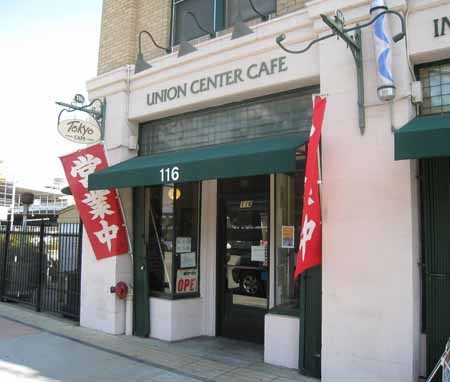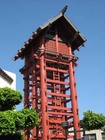This spring, ten students in the Occidental College Asian Studies seminar “Japanophilia” had the opportunity to get to know some of the business leaders of the Japanese American community in Little Tokyo, Los Angeles. The seminar is unusual, looking at the historical connection between Japanese self-identity and Western fascination with Japanese culture, while also considering the complex interconnections among race, gender, power, and identity around similar issues in the U.S. today. One of my goals as the instructor of the course is to encourage students to be more reflexive about their own identities, their involvement in consumer culture, and their engagement with local neighborhoods.
I have previously partnered in a similar fashion with the Little Tokyo Service Center, the Pavilion for Japanese Art at the Los Angeles Country Museum of Art, and the Japanese American National Museum’s “Landscaping America” exhibition, but this time worked directly with Vicky Murakami-Tsuda and her coworkers at the Discover Nikkei project. Vicky suggested that the Oxy students could profile local Japanese-American-owned businesses that would provide unique viewpoints on the history of the neighborhood as well as present day issues.
The challenges were twofold. On Vicky’s side, she had to work hard to find business proprietors who were not just willing but also had time to meet with students for interviews during the busy spring. On Oxy’s side, I had to ensure that the students were paired together around crowded class and working schedules, and also verify that each pair had access to a car as well as permission from the college to drive on official school business. Students prepared by reading Eiichiro Azuma’s Between Two Empires: Race, History, and Transnationalism in Japanese America, which gave them some sense of the historical context for the interviews.
Once these details were taken care of, we began the project. Vicky visited our seminar and introduced the students to the technical side of Discover Nikkei. Next the students visited the museum and also took the “Lifelong Learning Little Tokyo Walking Tour,” led by the amazing Bill Shishima. This tour was invaluable because it both gave the students a sense of the real people, the lived experiences, and the overlapping communities that make up Little Tokyo, and it provided practical knowledge about the neighborhood that would allow them to visit repeatedly thereafter. Vicky provided each pair of students with contact information for their assigned business as well as access to an interpreter if the proprietors preferred to speak in Japanese, and after that the work was entirely in the students’ hands. They borrowed digital recorders from the Audio Visual department at Oxy, made appointments to meet with their informants, and then visited—sometimes repeatedly—the Little Tokyo businesses.
At the time I knew very little about the progress of the project, but I later administered a detailed survey to learn more about the students’ experiences. It turns out that for each one the process of leaving campus and visiting Little Tokyo was transformative. One student reflected on how the project created a new relationship with the neighborhood: “I grew up in LA and I had really never been to Little Tokyo before besides to go to MOCA or just driving through. I really took a lot from the experience and feel like a have a special bond with the Little Tokyo community after learning so much about it, and especially after the personal interview.”
Another student wrote about the impact of the project on identity: “I really enjoyed getting off campus and into the neighborhood. Growing up in Hawaii I never really thought about race or ethnicity because everyone and everything is so diverse. Getting into Little Tokyo really opened up my eyes to the fact that minorities really do exist and play a big role in communities. Although I've never really paid any attention to the fact that I am full Japanese, visiting Little Tokyo filled me with a sense of pride as if I were an Issei.”
Having completed the interviews and collected various types of materials, the students next had to build web albums and write articles about their assigned businesses. Uploading images and writing a coherent narrative was challenging, but the fact that the product of their academic labor would become part of the public record of the community proved to be extremely valuable for the students.
One student wrote “I felt honored and privileged to be able to write an article about a popular local business for the Japanese American National Museum. To think that what [my partner] and I wrote about [our business] could be the last shred of evidence of the [business’s] existence really motivated us to write excellent articles. Knowing that our work would be published online for the public inspired me to not just write an article, but to tell a story of the history and success of this successful family business.”
Another student wrote “I was very, very excited to get to write an article for the Discover Nikkei website. It was much more rewarding to know that all our work will be available to a wider audience than the classroom. It was also great that we were able to contribute to the preservation of Little Tokyo history - the assignment had a true purpose.”
In a similar vein, another student commented that, “It’s amazing the pressure you feel to achieve perfection when you know that your work is essentially going to be published. It really made me reflect on my writing, and think how often we cut corners. I couldn't write anything without thinking of [my informant] and if she would approve of the way I had shared her story, or if there was a more appropriate, eloquent way to share something. It also really encourages you to double check that all of your facts are correct because otherwise your are misrepresenting someone that you have grown to like.”
To summarize, the depth and complexity of the stories and histories that the Little Tokyo business leaders shared with the students motivated them to take responsibility for their own work and to feel part of something larger than just this assignment, this class, or even this grade. The students became aware of themselves as agents of change, who could potentially use their knowledge, their skills, and dare I say their privilege to educate others. And this sense of empowerment came not from their teacher or from the museum but from the business leaders in the community.
The web albums and articles that resulted from this project do a great job of conveying the interesting stories of the businesses and proprietors that make Little Tokyo such a vibrant and interesting neighborhood. The relationships that were formed in the course of the project have lasted as well. Many of the students in the class commented to me that they have continued to visit Little Tokyo on a weekly basis. Some revisit the restaurants that they learned about through the project, while others have become explorers, searching out previously unknown establishments and acting as regular patrons of the neighborhood.
The students also reported that they consume differently now, with increased attention to the establishment, the products, and the context for their choices. In this particular historical moment, when so many young Americans are fascinated with Japanese popular culture but few pay attention to the history of the relationship between Japan and the United States, and even fewer know of the role of Japanese Americans in our shared global history, the increase in reflexivity and awareness of the Oxy students who completed this project shows, I think, that engaging with our local communities is a vital way to improve the quality and depth of college education.
© 2009 Morgan Pitelka






